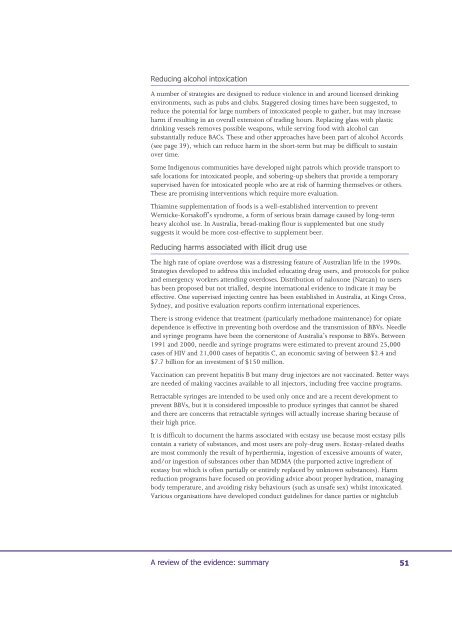Summary - Department of Health and Ageing
Summary - Department of Health and Ageing
Summary - Department of Health and Ageing
Create successful ePaper yourself
Turn your PDF publications into a flip-book with our unique Google optimized e-Paper software.
A number <strong>of</strong> strategies are designed to reduce violence in <strong>and</strong> around licensed drinking<br />
environments, such as pubs <strong>and</strong> clubs. Staggered closing times have been suggested, to<br />
reduce the potential for large numbers <strong>of</strong> intoxicated people to gather, but may increase<br />
harm if resulting in an overall extension <strong>of</strong> trading hours. Replacing glass with plastic<br />
drinking vessels removes possible weapons, while serving food with alcohol can<br />
substantially reduce BACs. These <strong>and</strong> other approaches have been part <strong>of</strong> alcohol Accords<br />
(see page 39), which can reduce harm in the short-term but may be difficult to sustain<br />
over time.<br />
Some Indigenous communities have developed night patrols which provide transport to<br />
safe locations for intoxicated people, <strong>and</strong> sobering-up shelters that provide a temporary<br />
supervised haven for intoxicated people who are at risk <strong>of</strong> harming themselves or others.<br />
These are promising interventions which require more evaluation.<br />
Thiamine supplementation <strong>of</strong> foods is a well-established intervention to prevent<br />
Wernicke-Korsak<strong>of</strong>f’s syndrome, a form <strong>of</strong> serious brain damage caused by long-term<br />
heavy alcohol use. In Australia, bread-making flour is supplemented but one study<br />
suggests it would be more cost-effective to supplement beer.<br />
<br />
The high rate <strong>of</strong> opiate overdose was a distressing feature <strong>of</strong> Australian life in the 1990s.<br />
Strategies developed to address this included educating drug users, <strong>and</strong> protocols for police<br />
<strong>and</strong> emergency workers attending overdoses. Distribution <strong>of</strong> naloxone (Narcan) to users<br />
has been proposed but not trialled, despite international evidence to indicate it may be<br />
effective. One supervised injecting centre has been established in Australia, at Kings Cross,<br />
Sydney, <strong>and</strong> positive evaluation reports confirm international experiences.<br />
There is strong evidence that treatment (particularly methadone maintenance) for opiate<br />
dependence is effective in preventing both overdose <strong>and</strong> the transmission <strong>of</strong> BBVs. Needle<br />
<strong>and</strong> syringe programs have been the cornerstone <strong>of</strong> Australia’s response to BBVs. Between<br />
1991 <strong>and</strong> 2000, needle <strong>and</strong> syringe programs were estimated to prevent around 25,000<br />
cases <strong>of</strong> HIV <strong>and</strong> 21,000 cases <strong>of</strong> hepatitis C, an economic saving <strong>of</strong> between $2.4 <strong>and</strong><br />
$7.7 billion for an investment <strong>of</strong> $150 million.<br />
Vaccination can prevent hepatitis B but many drug injectors are not vaccinated. Better ways<br />
are needed <strong>of</strong> making vaccines available to all injectors, including free vaccine programs.<br />
Retractable syringes are intended to be used only once <strong>and</strong> are a recent development to<br />
prevent BBVs, but it is considered impossible to produce syringes that cannot be shared<br />
<strong>and</strong> there are concerns that retractable syringes will actually increase sharing because <strong>of</strong><br />
their high price.<br />
It is difficult to document the harms associated with ecstasy use because most ecstasy pills<br />
contain a variety <strong>of</strong> substances, <strong>and</strong> most users are poly-drug users. Ecstasy-related deaths<br />
are most commonly the result <strong>of</strong> hyperthermia, ingestion <strong>of</strong> excessive amounts <strong>of</strong> water,<br />
<strong>and</strong>/or ingestion <strong>of</strong> substances other than MDMA (the purported active ingredient <strong>of</strong><br />
ecstasy but which is <strong>of</strong>ten partially or entirely replaced by unknown substances). Harm<br />
reduction programs have focused on providing advice about proper hydration, managing<br />
body temperature, <strong>and</strong> avoiding risky behaviours (such as unsafe sex) whilst intoxicated.<br />
Various organisations have developed conduct guidelines for dance parties or nightclub

















